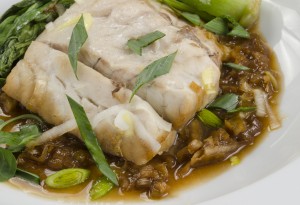Cooking with the Muse Combines Literature and Cuisine
check out this link: Table Hopping with Rosie
This gorgeous 500-page cookbook with 150 international recipes and full-color photographs, also contains culinary poetry, essays and historical information.
COOKING WITH THE MUSE
BY MYRA KORNFELD AND STEPHEN MASSIMILLA
A Sumptuous Gathering of Seasonal Recipes, Culinary Poetry and Literary Fare
This gorgeous 500-page cookbook with 150 international recipes and full-color photographs contains culinary poetry, essays and historical information relevant to the ingredients in the recipes. Not only do the appealing recipes use seasonal produce, pasture-raised animals, wild seafood and traditional fats, but this book is one hell of a good read.
Cooking With The Muse is divided by season. For example, you will find apples and corn highlighted in autumn; root vegetables in the winter; asparagus and lamb in the spring; and salads and fruits in the summer. Global dishes include Vietnamese Chicken Pho, Moroccan Braised Lamb shanks or Short Ribs, Goan Green Coconut Fish Curry and Turkish Cherry Tomato Salad with Pomegranate Molasses Dressing.
Chef Myra Kornfeld has authored three previous cookbooks: The Healthy Hedonist, The Healthy Hedonist Holidays, and The Voluptuous Vegan. She teaches in the graduate nutrition program at the Maryland University of Integrative Health and The Natural Gourmet Institute. Poet, critic, and professor, Stephen Massimilla teaches literature, food ethics, and writing at Columbia University and the New School.
Here is a recipe from the book along with sample poetry by Stephen Massimilla:
Local Market Sea Trout
Ice-ribbed vessel—prow
flashing among waves and waves
of spring lettuces.
Seasonal Haiku
Spring blurring branches—
drizzled skies, cool drops plopping
in the eyes of fish.
Sea Trout in Miso
This recipe is simple-seeming, like a haiku. As Japanese chefs know, there is a term, umami, for the fifth “meaty” taste, as exemplified by the miso in this dish. (see the Poet’s Note.) As Japanese poets know, there is another term, mono no aware, for mixed emotional flavors, frequently translated as “the ‘ahh-ness’ of things,” the sweet sadness in empathizing with the beauty of what must pass away. This quality is exemplified in the freshness of the fish and spring greens.
This Japanese-inspired dish features market sea trout, also known as weak fish. It’s gently braised with ginger, leeks, shoyu, and sake; it is then finished with miso and fresh greens such as bok choy or tat soi. This easy-to-make, one-pot meal requires only a bit of rice to round everything out.
Sea trout is an omega-3-rich fatty fish, but mackerel, blue fish, or black cod are delicious in this recipe as well. The miso glaze is robust enough to tame the assertive fish and bring out its rich flavor.
Serves 4
2 tablespoons shoyu (natural soy sauce) or tamari
3 tablespoons sake or mirin
1 cup water
2 teaspoons natural brown sugar (preferably maple or succanat or coconut)
4 (5-ounce) sea trout, weakfish, mackerel, bluefish, or black cod fillets, skinned
1 cup leeks thinly sliced, white and light green part only
2 tablespoons minced peeled fresh ginger
3 tablespoons sweet white miso, or any light or mellow miso
½ pound spring greens (such as tat soi, bok choi, or braising mix)
¼ cup thinly sliced scallions (whites and greens)
Handful of pea shoots, for garnish.
1. Whisk together the shoyu, sake, water, and sugar in a large straight-sided skillet. Bring to a boil.
2. Lower the heat to a simmer and add the trout along with the leeks and ginger. Cover and simmer gently until the fish is cooked through, about 5 minutes (depending on the thickness of the fish).
3. Gently remove the fish from the skillet. Whisk the miso thoroughly into the pan liquid. Raise the heat. Add the greens and simmer rapidly, uncovered, until the sauce is thickened, 2 to 3 minutes.
4. Serve the fish hot on a bed of the sauce and spoon some greens over the tops of each fillet as well. Garnish with a sprinkling of scallions, and pea shoots, if using.
Poet’s Note
Scholars believe that miso was first developed in China 2,000 years ago. Confucius approved of it. It is said to have been brought to Japan, along with Buddhism, in the 6th century.
The fermented paste of soy beans and a grain such as rice or barley, miso is traditionally aged anywhere from three months to three years. In this dish, use the younger “sweet” or “mellow” varieties (look for those words, or “light” on the label), which have been aged for only about three months.
Miso is high not only in protein and vitamins; it lends more to this dish than a combination of saltiness and sweet fruitiness, more than the sum of its savors. Distinct from foods that impart only sweetness, sourness, saltiness, and/or bitterness, miso imparts a hint of umami, which means “yummy” in Japanese. Contesting Democritus, Plato, and Aristotle, the great French chef August Escoffier discovered this fifth savory taste, that of naturally occurring glutamates. A Japanese chemist later verified its existence, giving it a name that sounds quite poetic and exotic to non-Japanese speakers.

